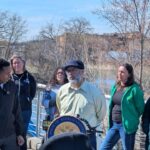The summer of 1776 had been a disastrous season for the American Revolution. George Washington had lost the battle of Brooklyn in August, was forced to abandon New York City in September, and by late October he was marching his tattered army northward along the west bank of the Bronx River to avoid being trapped on Manhattan Island by British forces that had landed around New Rochelle.
White Plains was a crossroads town commanding one of the few bridges over the Bronx River (or “Brunks” River as the maps of the day termed it.) More importantly, it held a depot of desperately needed supplies.
Reaching White Plains ahead of the British, the Americans dug in along a line of hills just north of present-day Main Street, determined to hold on long enough to ensure that the slow-moving supply wagons were safely north on the road to Peekskill. Almost as an afterthought Washington posted several regiments on the crest of Chatterton Hill, which sharply rose along the west bank of the Bronx River, and from which they could threaten the flank of the British if they attacked the American main line. Ordered by Washington to “do the best you can,” the Americans fortified the place as best they could with cornstalks and awaited the enemy while Alexander Hamilton placed his two-gun battery in a commanding position near the hill’s highest point.
The British arrived on October 28th. After an initial clash in Scarsdale, the British and Hessians stormed across the shallow Bronx River and mounted an assault up the steep wooded slopes of Chatterton Hill. Twice they were forced back with heavy casualties, until a Hessian Colonel named Johann Rall took his soldiers around the southern slope. Now attacked on two sides, the Americans retreated off the north end of the hill, crossed the bridge over the Bronx River, and rejoined the rest of their army.
The British paused, awaiting reinforcements. Then for the next two days it rained, making it impossible to fire their flintlock muskets. By the time the rain ended on November 1st, Washington had pulled back to the hills of North Castle, and now occupied an even stronger position than before. There was now no possibility of trapping Washington and little reason to pursue him northwards, so the British turned and marched back to Manhattan to capture Fort Washington and secure the island.
Though termed inconclusive by many historians, the battle of White Plains had several outcomes. It marked the failure of the last opportunity to trap Washington and end the Revolution, and it marked the arrival of the Hessians as a significant fighting force. White Plains also helped make the careers of three people: Alexander Hamilton, who once again distinguished himself as a young artillery captain; Johann Rall, whose initiative as a Hessian commander that day eventually gained him the command of a place called Trenton on the Delaware River; and the Headless Horseman, the nameless Hessian who lost his head at Chatterton Hill, and who legend has it went on to haunt Sleepy Hollow.
Stephen Paul DeVillo




